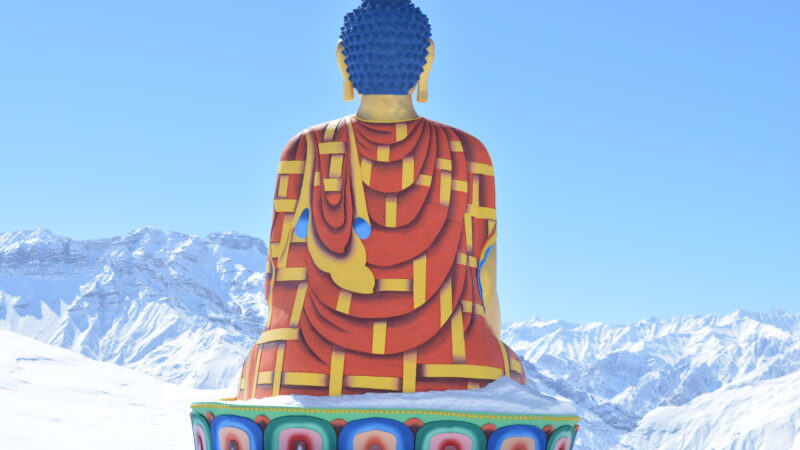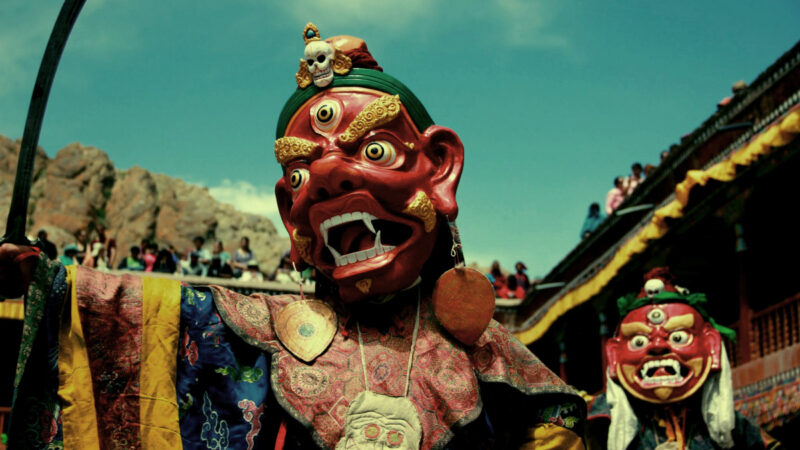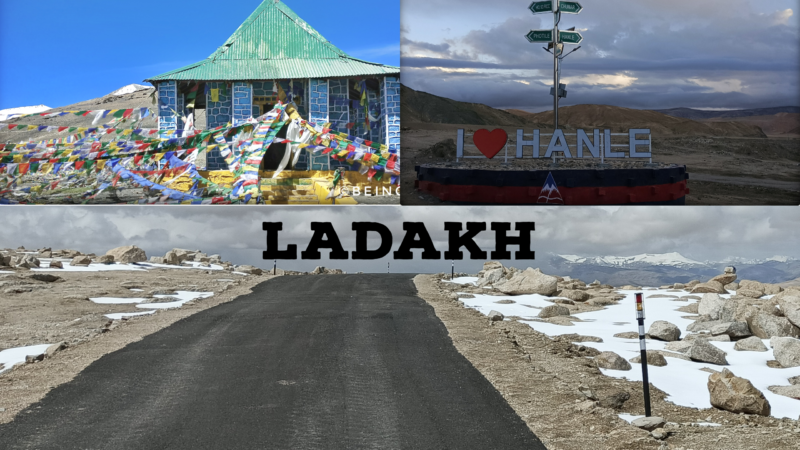Being Himalayan
Your Gateway to the Himalayas !
Spiti, Ladakh & Himachal Tours
Your Curated Himalayan Road Trip Starts Here!
We don’t just take you to the Himalayas — we help you belong there.
Why Choose Being Himalayan for Your Next Trip?
End to End Road Trips
From itinerary to stay, we handle it all.
Well Maintained Cabs & Trusted Drivers
Experienced, Local and Always Reliable.
Verified Hotels & Homestays
We only Book what we personally trust.
Shimla Based, Real Himalayan Experts
Not Just Agents, We're Travellers too!
Carefully curated Himalayan tour packages and itineraries, designed to make planning your dream vacation simple and enjoyable.
Top Road Trip Packages in the Himalayas
Uncover the breathtaking beauty of destinations like Spiti Valley, Ladakh, Himachal Pradesh, and Kashmir, each known for its unique landscapes and vibrant culture.

Spiti Valley Circuit Tour - 9 Days via Shimla & Manali
Chandigarh - Narkanda (1N) - Chitkul (1N) - Kalpa (1N) - Tabo (1N) - Kaza (2N) - Chandratal (1N) - Manali (1N) - Chandigarh Drop

Epic Ladakh 10-Day Itinerary– Nubra, Pangong, Hanley, Tso Moriri
Leh Airport – Leh (2 N) – Nubra (2 N) – Pangong (1 N) – Hanle (2 N) – Tso Moriri (1 N) – Leh (1 N) – Leh Airport Drop

Spiti Valley and Ladakh Tour | 16 Nights / 17 Days | An Epic Road Trip
Chandigarh – Manali (1N) – Kaza (2N)– Tabo (1N) – Chandratal (1N) - Keylong (1N) – Sarchu (1N) – Leh (2N) – Nubra (2N) – Pangong (1N) – Hanle (2N) – Leh (1N) - Kargil (1N) – Srinagar Drop
How it Works?
Choose Your Tour
Browse our curated road trip packages or share your travel goals with us.
Customize Your Journey
We tailor your itinerary, hotels, cab, and sightseeing — exactly how you like it.
Confirm & Go !
Review the final offer, approve it, and we’ll handle everything else for you.
Build your Trip!
What Travellers Say About Being Himalayan
Planning of itinerary and its execution on ground for a 9 N 10 D Spiti Valley via Kinnaur trip (14 -23 Jun 2024) was very smooth and professional. Suggestions for and choice of hotels were spot on. Vehicle provided was very well maintained and the driver was highly skilled and efficient. We had inadvertently left behind some items at Kalpa and did not realise it. The tour operator contacted us through the manager of our next destination hotel (Tabo) since we were out of our service provider’s mobile network. After confirmation and making us realise our lapse he had the items delivered to our next destination hotel (Kaza). Our overall experience was fabulous and this was the best tour package vis-à-vis its cost that we have undertaken till date. Highly recommend Being Himalayan and rate it more than 5/5.
All services was good. Rahul bhai arranged everything properly and systematically. So no chance abt inconvenience anywhere. Such cooperation was needed when we were in adventurous tour. Height and health may not permit bt Rahul bhai was there to monitor all kinds of hazards. I choose Being Himalayan as senior citizen in Ladakh trip. You also make friendship with them and go ahead.
We strongly Recommend Being Himalayan Tour Organisers for Planning and Organising Tours to North INDIA ! They have Wast Experience in it ! We are Traveling with them since last 3 years now !
I had taken a Trekking trip with them to Kuppar bugyal in Oct 21. The team was extremely professional. We camped for a day at the top. The team of Arun, Vikas, Ramesh and another Gentleman (Whose name I am forgetting) were extremely professional and know their job well. We were well received at Khara patthar and were taken to the peak at a pace that suited our physical capability. I would definitely choose them again if I have to go for trekking
These guys are the BEST IN BUSINESS!
We have planned for a customized trip to Shimla - Spiti Valley - Chitkul with Being Himalayan in Jun'19 and it was amazing!
The fun part is that I have reached to Rahul Sharma just after seeing his answers on one of the Quora threads.After checking out few options online,I have reached out to Rahul and have been in touch with him for more than a month for planning and knowing the details about Himachal(Leh-Ladakh and Spiti trips).
After a series of discussions,the team was extremely patient to come up with a perfect itinerary as requested by us.The trip was planned very well throughout,right from Delhi until we reached back to Delhi again!
One minute gesture by the team- the team at BH was also tracking our live location (despite the network issues) and were guiding us with the best and optimal routes until we reached our intended destinations on a daily basis.This minute gesture itself speaks volumes about their customer service.
The hotels provided to us(not to forget the amazing hosts at the hotel),the food,the driver(again,one amazing driver - Gurjeet bhaiyya :D) and the vehicle(tempo-12 seater) were of top quality.
This was our first trip in the Northern side of India and this is probably the best trip's I've planned , at a best price!Also,at any point we did not felt like we were planning this with an external party -Thanks to the amazing team at BH ,they have been extremely cordial and patient to help us have the trip with what exactly we wanted!
One suggestion to everyone who intend plan for a trip with Being Himalayan,shoot as many questions as possible to the BH team to customize and know your routes&destinations in detail,Rahul and team will be more than happy to help you!
Thanks again to Being Himalayan team and see you soon,Himachal
We have planned for a customized trip to Shimla - Spiti Valley - Chitkul with Being Himalayan in Jun'19 and it was amazing!
The fun part is that I have reached to Rahul Sharma just after seeing his answers on one of the Quora threads.After checking out few options online,I have reached out to Rahul and have been in touch with him for more than a month for planning and knowing the details about Himachal(Leh-Ladakh and Spiti trips).
After a series of discussions,the team was extremely patient to come up with a perfect itinerary as requested by us.The trip was planned very well throughout,right from Delhi until we reached back to Delhi again!
One minute gesture by the team- the team at BH was also tracking our live location (despite the network issues) and were guiding us with the best and optimal routes until we reached our intended destinations on a daily basis.This minute gesture itself speaks volumes about their customer service.
The hotels provided to us(not to forget the amazing hosts at the hotel),the food,the driver(again,one amazing driver - Gurjeet bhaiyya :D) and the vehicle(tempo-12 seater) were of top quality.
This was our first trip in the Northern side of India and this is probably the best trip's I've planned , at a best price!Also,at any point we did not felt like we were planning this with an external party -Thanks to the amazing team at BH ,they have been extremely cordial and patient to help us have the trip with what exactly we wanted!
One suggestion to everyone who intend plan for a trip with Being Himalayan,shoot as many questions as possible to the BH team to customize and know your routes&destinations in detail,Rahul and team will be more than happy to help you!
Thanks again to Being Himalayan team and see you soon,Himachal
Himalayan Travel Tips & Blogs
Our carefully curated Himalayan tour packages and itineraries are designed to make planning your dream vacation simple and enjoyable. From thrilling road trips through the mountains to serene nature retreats, we offer a variety of options for every type of traveler
FAQ's (Frequently Asked Questions)
Is the Tour customizable?
Yes, every package can be adjusted for your needs.
Are drivers and vehicles safe?
Absolutely. We use only verified local drivers.
What is the best time to visit Himachal Pradesh, Spiti Valley, and Ladakh?
Himachal Pradesh:
- March-June & September-November: Pleasant weather, ideal for outdoor activities, trekking, and sightseeing.
- December-February: Snowfall, perfect for winter sports (skiing, snowboarding), but some areas may have limited access.
Spiti Valley: June-September (roads open, pleasant weather for travel and trekking).
Ladakh:
- May-September: Roads accessible, ideal for most travelers, pleasant temperatures for sightseeing and outdoor activities.
- November-February: Suitable for Chadar Trek and winter landscapes, but requires careful planning and cold-weather gear, some accommodations may be closed.
What are the must-visit places in Spiti Valley?
- Key Monastery: Ancient Buddhist monastery with stunning architecture and intricate murals.
- Chandratal Lake: Beautiful crescent-shaped lake, ideal for camping and photography.
- Dhankar Monastery: Clifftop monastery offering panoramic views of the valley.
- Langza & Komik: Highest motorable villages in the world, known for their unique culture and stunning landscapes.
What are the top attractions in Ladakh?
- Pangong Tso Lake: High-altitude lake famous for its changing colors, a must-visit for any visitor to Ladakh.
- Nubra Valley: Home to the sand dunes of Hunder and Bactrian camels, offering a unique desert experience in the mountains.
- Magnetic Hill: A gravity-defying phenomenon near Leh, a popular tourist spot.
- Hemis Monastery: The largest and most renowned monastery in Ladakh, famous for the Hemis Festival.
How many days are ideal for exploring Spiti Valley and Ladakh?
- Spiti Valley: 7-10 days to comfortably cover key areas like Kaza, Key Monastery, Langza, and Chandratal.
- Ladakh: 10-14 days to explore Leh, Nubra Valley, Pangong Tso, Tso Moriri, and other key attractions.
- Spiti Valley + Ladakh : Around 15-20 Days Recommended. Checkout this Adventurous Spiti & Ladakh Itinerary for 17 days.
What are the unique features of Spiti Valley and Ladakh?
- Spiti Valley: Stark, arid landscapes, ancient monasteries, unique Tibetan Buddhist culture, and a peaceful, less crowded atmosphere.
- Ladakh: Vibrant Buddhist culture, high-altitude lakes, stunning mountain scenery, iconic road trips like the Manali-Leh Highway, and a unique blend of Tibetan and Indian influences.
What adventure activities are available in Spiti Valley and Ladakh?
- Spiti Valley: High-altitude trekking (Pin Parvati Pass, Kinnaur to Spiti), mountain biking, stargazing, and village homestays.
- Ladakh: River rafting on the Zanskar River, trekking (Markha Valley, Chadar Trek), motorbiking on the Leh-Manali Highway, and jeep safaris.
Can I self-drive to Spiti Valley and Ladakh?
- Yes, but with caution. Roads are challenging with steep inclines, rough patches, and river crossings.
- Spiti Valley: Accessible via Shimla (year-round) and Manali (June-September).
- Ladakh: Use the Srinagar-Leh Highway or Manali-Leh Highway (open May to October). An SUV or 4×4 vehicle is highly recommended.
- Yes, but with caution. Roads are challenging with steep inclines, rough patches, and river crossings.
What are some Must have Experiences in Spiti & Ladakh?
- Spiti Valley: Attend festivals like Losar (New Year), participate in village homestays, explore the ancient murals in monasteries, and interact with the local people.
- Ladakh: Don’t miss the Hemis Festival, visit traditional Ladakhi homes, try yak butter tea and skyu (a traditional dish), and learn about local Buddhist culture and traditions.
What are some hidden gems in Himachal Pradesh, Spiti Valley, and Ladakh?
- Himachal: Tirthan Valley, Jibhi, Barot, and the Kangra Valley.
- Spiti Valley: Pin Valley, Gue (mummy of a Buddhist monk), Nako Lake, and the villages of Komic and Langza.
- Ladakh: Hanle for stargazing and wildlife, Turtuk for Balti culture, and the remote Pangong Tso North.
Are permits required for Spiti Valley or Ladakh?
- Spiti Valley: Inner Line Permits are required for foreigners for areas near the Tibet border, such as Tabo and Dhankar. Indian citizens generally don’t need permits.
- Ladakh: Inner Line Permits are mandatory for Pangong Tso, Nubra Valley, Tso Moriri, and Hanle. These can be obtained online or in Leh.
What is the best way to reach Spiti Valley and Ladakh?
- Spiti Valley:
- Via Shimla: Year-round, longer but safer route.
- Via Manali: Open June-September, shorter but more challenging.
- Ladakh:
- By Road: Srinagar-Leh (May-November) or Manali-Leh (June-October).
- By Air: Direct flights to Leh are available year-round.
- Spiti Valley:
Which places are best for family vacations in these regions?
- Himachal: Shimla, Manali, Dalhousie, and Dharamshala offer family-friendly accommodations and activities.
- Spiti Valley: Dhankar and Tabo are more accessible and offer a taste of local culture.
- Ladakh: Leh, Nubra Valley, and Pangong Tso offer family-friendly accommodations and activities, but be prepared for high altitudes.
Is acclimatization necessary for Spiti Valley and Ladakh?
- Yes, absolutely. Both regions are at high altitudes, increasing the risk of altitude sickness. Spend 1-2 days at lower altitudes (Manali/Shimla for Spiti, Leh for Ladakh) to adjust. Stay hydrated, avoid alcohol, and consider consulting a doctor about altitude sickness medication.
Can I visit Spiti Valley and Ladakh during winter?
- Yes, but only for experienced travelers. Extreme cold, limited accommodation options, and road closures may occur.
- Spiti Valley: Accessible via Shimla route, enjoy frozen rivers and snow-covered landscapes.
- Ladakh: Suitable for the Chadar Trek and experiencing Tso Moriri Lake in its frozen glory.
- Yes, but only for experienced travelers. Extreme cold, limited accommodation options, and road closures may occur.
Fully Customizable, Safe & Comfortable Journeys
Best Tour Packages for The Himalayas
Need Help Planning The Trip?
Share Your Plan - Get a Package - Your Confirm (after any changes if required) - We Arrange & Book Everything !
You’re not here by accident — something inside you is already picturing the winding roads, crisp air, and snow-kissed peaks.
Let’s make that vision real.
Tell us where it begins — and we’ll craft the rest, just for you.
